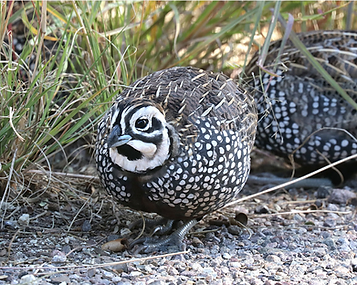Water for Quail
Unfortunately, Montezuma Quail habitat is in decline as accelerated erosion caused by land-use change such as development, mining, ranching, and agriculture strips away vegetation that the quail require for cover and food. At the same time, climate change, increasing aridity, and changes to surface water flows decrease soil moisture required to support tuberous Montezuma Quail food plants such as wood sorrel. Combined, these impacts create a landscape that is drier, more fragmented, and less vegetated.


A one-rock dam built within a small ephemeral channel will help slow water flow and trap sediment, increasing infiltration and soil moisture and mitigating erosion.

BRN Restoration Crew Lead Zach Farley teaches high school students to build erosion control structures to help restore Montezuma quail habitat.
Project Overview:

Impacts to habitat can be observed throughout the range of Montezuma Quail, and the BWP is no exception. Montezuma Quail are most often observed in the central section of the preserve where eroding ephemeral drainages slice through the oak and mesquite-dotted grasslands, quickly draining the land of moisture when precious water flows through it. To combat this landscape and habitat degradation, the Sonoran Joint Venture’s Awards Program generously awarded Borderlands Restoration Network (BRN) over $25,000 total in 2019 and 2020 to implement restoration interventions at the BWP to benefit Montezuma Quail and other species that depend on this critical habitat.
This funding was used to implement a multi-pronged restoration approach that started with the restoration of water flows across the landscape. This was accomplished through the construction of over 270 log and rock erosion control structures placed within the eroding drainages perpendicular to the flow of water. These structures protrude about 4-12” above the channel bottom, physically slowing water flow, capturing sediment, and pooling water so that it can infiltrate into the ground. This allows for recharging groundwater and increasing soil moisture while reducing erosion.
Native seed sourced from local wild populations was then distributed within and around the structures, encouraging the re-establishment of native vegetative communities to increase habitat function, increase water retention in the landscape, and further reduce erosion through the stabilizing effect of root systems on the soil. Seed was distributed in the form of seed pellets, which are a combination of naked seed, compost, diatomaceous earth, and clay. These ingredients are mixed with water in a small concrete mixer until small pellets are formed. Pellets are then cast onto the ground, where they are protected from predation until rain comes. The rain dissolves the pellets and allows the seeds to germinate.
Avian surveys were incorporated into this project to provide insight into how restoration activities impact Montezuma Quail and other bird populations. Tucson Audubon Society was contracted to run these surveys due to their expertise in this bird monitoring techniques and their robust volunteer base. Four transects were selected for the surveys and included the two drainages where restoration work was conducted, and two control drainages where no restoration work was done. Baseline conditions were established in the first year of the project before the rainy season, with five surveys per year scheduled thereafter. Surveys are still underway, and results are pending.
Volunteers have been a critical piece of the restoration process. In addition to assisting with the bird surveys, visiting education groups and public volunteer events have contributed over 200 hours of volunteer labor by assisting in seed cleaning and erosion control structure building, further expanding the impact of this project through hands on education about Montezuma Quail, impacts to their habitat, and restoration solutions. We look forward to seeing the benefits of this hard work over the coming years.


